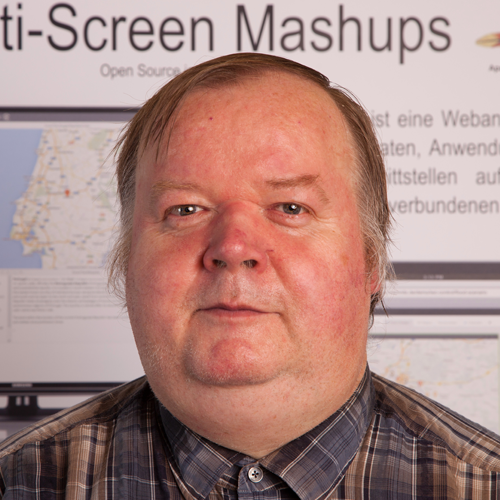Service Infrastructures
Situation / Problem / Solution requirements
Goal
Objectives
Responsible


Contact Person


Nachwuchsforschergruppe DYNAMIK
2020/01 - 2022/12
The National Action Plan 2.0 for the UN Convention on the Rights of Persons with Disabilities of June 2016 as well as several legislative proposals are targeted a way to an inclusive society. Our Vision of the Junior Research Group DYNAMIK (Dynamic Navigation and Orientation System for Physical impaired people in complex buildings) it is at this point, solutions to explore for a comprehensive and equal social participation of people with disabilities and the results in the Saxon industry.

Crossmediale Mehrwertdienste für die digitale Mediendistribution
2012/08 - 2014/12

MockupDD
2012/01 - 2013/12
MockupDD project intends to combine the high degree of end-user involvement provided by agile methodologies, with the productivity provided by MDWE (Model-Driven Web Engineering). MockupDD uses interface mockups (popular in code-based agile processes) to gather interaction and functional requirements, and then reuses them throughout the whole development process as valuable model specifications. These specifications provide also the foundation required to generate running web applications (even partially) by following an iterative enrichment process. MockupDD intends to be a hybrid agile and model-driven methodology to analyze, design and implement web applications. It promotes intensive end-user participation by incorporating user interface mockups as a common language between them and the development team. At the same time, MockupDD relies in the productivity provided by MDWE methodologies to quickly derive web applications from high-level models.

Data Grid Service
2007/10 - 2013/07
The WebComposition/DGS continues the research within the WebComposition field and constitutes the first component of the fourth generation of the WebComposition approach. The WebComposition/DGS addresses the increasing need to store, access, manage and to publish ultra large amounts of data over the World Wide Web using a RESTful approach. The developed component addresses both, complex business-related scenarios as well as requirements in the context of Web2.0. The formal description of system-transcending relations allows furthermore modeling the interaction of different system components.

Research and Development for ARC Solutions
2009/01 - 2009/12
The project is concered with platform-independent access to and control of a product lifecycle management software (Siemens Teamcenter) by using a web service interface.

Research and Development for GIG-E-Vision / BGAPI
2007/08 - 2009/08
The project focuses research and development of drivers and platform-independent applications for the GIG-E-Vision standard. GIG-E-Vision allows the connection of cameras and computers via Gigabit-Ethernet.

Web-based Federation Technologies for Science
2007/04 - 2008/12
The research project Web-based Federation Technologies for Science (codename "Hanoi") is concerned with the practical application of federated Web technology in real-life scenarios. This covers e.g. single-sign on access across Web sites, inter-organizational use of Web services, or federation management with the help of architecture registries.

Federated System Modeling
2005/01 - 2007/10
Project Nevada is concerned with modeling organization-spanning Web-based systems with respect to federation techniques studied in the context of the Kenya project. As a major subject of research, the WebComposition Architecture Model (WAM) is developed, comprising graphical modeling notations, machine-readable model representations as well as infrastructure services based on the modeling information.

Bildungsmarkt Sachsen
2003/01 - 2007/07
The BMS project deals with the conception, development and operation of an education information system in the form of a Web portal. The mission of this portal is to provide unified access to educational offers within the Free State Saxony. Project activities also involve the creation of interfaces for the exchange of data between multiple institutions and enterprises.

Service Infrastructure Systems for Federated Identity Management
2003/11 - 2007/04
The goal of the Kenya project is to provide support by system and support by method for scenarios of federated identities. The support by system includes a software infrastructure to support delegated, decentralized and federated authentication and identity management for the Web by partially implementing specifications on top of specifications like WS-Federation and SAML. The support by method consists of concepts and methods for developing and maintaining distributed systems with identities originating from multiple trust realms.
- VRML97Viewer
- Unterstützung von Personalisierungsdiensten, unter Berücksichtigung der Privatsphäre in firmenübergreifenden Szenarien
- Konzeption einer Serviceinfrastruktur für den Informationsfluss zwischen verteilten Systemen
- Web-Service-basierte Kooperationsplattformen für virtuelle Teams am Beispiel der Produktionslayoutplanung
- Ein modellbasierter Ansatz zur Sicherheitsanalyse von IT-Infrastrukturen
- Weiterentwicklung des Netzwerkpraktikums
- Open-IDFS
- Asynchrone Ereignis-Benachrichtigungen für föderative Verzeichnisdienste
- A Framework for Generating Adaptable User Dialogs from Document Content Definitions
- Data Grid Service Architecture
- Evaluierung von Zugriffstechniken auf eine MSSQL Datenbank und Umsetzung im DataGridService
- Unterstützung der Anwendungsentwicklung im Kontext Linked Data
- FOAF und FOAF+SSL zur Realisierung von SingleSignOn im idFS System
- Analyse, Bewertung und Vergleich verschiedener Ansätze zur Overlay-Underlay-Interaktion im Bereich des Internets
- Eine Publish-Subscribe-Infrastruktur für Linked-Data-Applikationen
- Dezentrale Autorisierung in Linked-Data-Applikationen
- Modellgetriebene Unterstützung von End User Development für Daten-intensive Web-Anwendungen
- Workflow-Management mit WebComposition/DataGridService
- Linked Data-orientierte Verwaltung von Binärdaten auf Basis von WebComposition/DataGridService
- Malware Frühwarnung in lokalen Netzwerken
- Unterstützung der Evolution datenintensiver Web-Anwendungen mittels WebComposition/Data Grid Service und Apache CouchDB
- Ranking Web Services Using Centralities and Social Indicators
- Cloud Computing-basierte Datenspeicherlösungen am Beispiel des Data Grid Service und Windows Azure
- Erweiterung des CSN-Dienstangebotes für Forschung und Sicherheit
- Sicheres Speichern in der Cloud mit Unterstützung von Multi-User-Szenarien
- End-nutzer-orientierte Archivierung und Auffindung von Web-basierten Medieninhalten
- Supporting Teams with Collaborative Goal Management
- Rapid web migration prototyping using WebAssembly
- Motivationssteigerung im mHealth-Bereich mittels Gamification
- Knowledge Graph Engineering using Large Language Models





